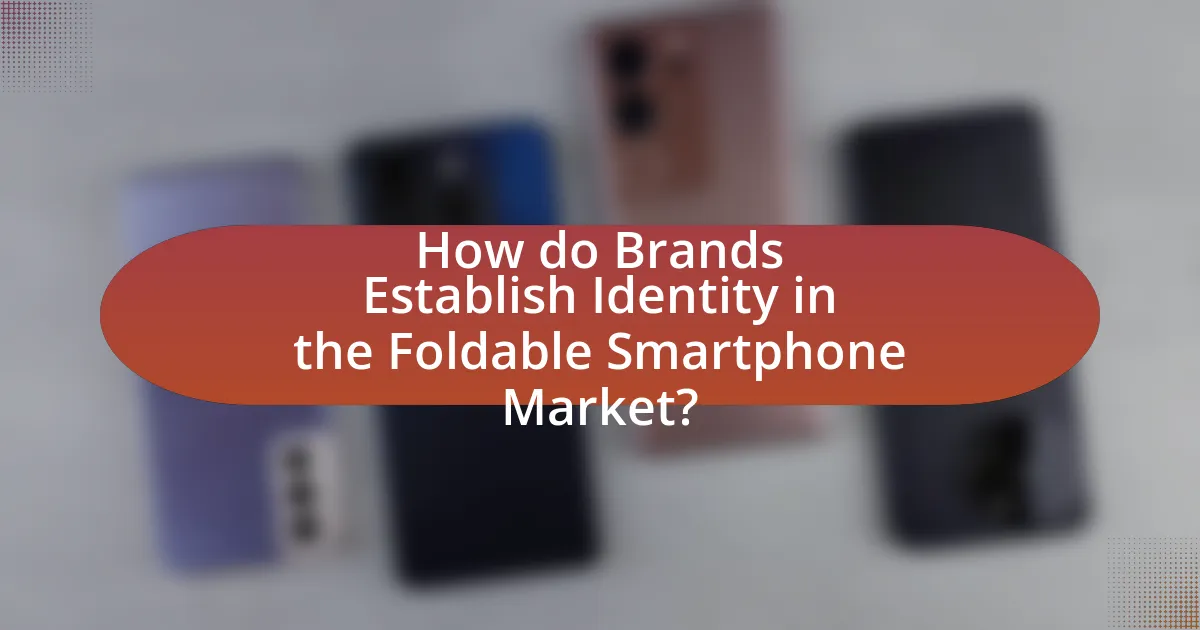Foldable smartphones, characterized by their flexible screens that allow for a compact design while providing a larger display area, are rapidly gaining popularity due to advancements in technology and consumer demand for multifunctional devices. This article explores the differences between foldable and traditional smartphones, key features, and the impact of design on user experience. It also examines the factors driving the rise of foldable smartphones, including technological advancements and consumer preferences, while addressing challenges such as durability and pricing. Furthermore, the article discusses how brands establish their identity in this emerging market and the implications of brand loyalty on consumer trust and future innovations in foldable smartphone technology.

What are Foldable Smartphones and Why are They Gaining Popularity?
Foldable smartphones are mobile devices that feature flexible screens, allowing them to be opened and closed like a book, thus providing a larger display area in a compact form. Their popularity is increasing due to advancements in technology, which have improved durability and usability, as well as consumer demand for multifunctional devices that combine the portability of smartphones with the larger screen experience of tablets. According to a report by Counterpoint Research, foldable smartphone shipments are expected to grow significantly, with a projected increase of over 50% year-on-year, indicating a strong market trend towards this innovative form factor.
How do Foldable Smartphones differ from Traditional Smartphones?
Foldable smartphones differ from traditional smartphones primarily in their design and functionality, allowing for a larger display area that can be compacted into a smaller form factor. Traditional smartphones typically feature a fixed, flat screen, while foldable smartphones utilize flexible displays that can be folded or unfolded, enabling users to switch between a compact phone size and a tablet-like experience. This innovation is supported by advancements in materials and technology, such as OLED displays and hinge mechanisms, which have made foldable designs feasible and durable. For instance, Samsung’s Galaxy Z Fold series showcases this capability, offering a 7.6-inch main display that folds into a device that fits comfortably in a pocket, contrasting sharply with the static dimensions of conventional smartphones.
What are the key features of Foldable Smartphones?
Foldable smartphones are characterized by their ability to open and close, allowing for a larger display area while maintaining a compact form factor. Key features include flexible displays, which utilize OLED technology to bend without breaking; multi-tasking capabilities, enabling users to run multiple applications simultaneously on a larger screen; and enhanced portability, as they can easily fit into pockets when folded. Additionally, many foldable smartphones incorporate advanced hinge mechanisms that ensure durability and smooth operation, with some models achieving over 200,000 folds in testing. These features collectively enhance user experience by combining the functionality of a tablet with the convenience of a smartphone.
How does the design of Foldable Smartphones impact user experience?
The design of foldable smartphones significantly enhances user experience by providing versatility and increased screen real estate. This innovative design allows users to seamlessly transition between a compact device for portability and a larger display for multitasking and media consumption. For instance, a study by Counterpoint Research in 2021 indicated that foldable smartphones can improve productivity by up to 30% due to their ability to run multiple applications simultaneously on a larger screen. Additionally, the unique form factor of foldable devices often attracts users seeking cutting-edge technology, thereby influencing brand identity and consumer perception.
What factors are driving the rise of Foldable Smartphones?
The rise of foldable smartphones is primarily driven by advancements in display technology, consumer demand for multifunctionality, and innovative design aesthetics. Advancements in OLED and flexible display technologies have enabled manufacturers to create devices that can bend without compromising screen quality, enhancing user experience. Additionally, consumers increasingly seek devices that combine the capabilities of a tablet and smartphone, leading to a preference for foldable designs that offer larger screens in a compact form. Furthermore, brands are leveraging unique designs to differentiate themselves in a saturated market, appealing to tech-savvy consumers who value innovation and exclusivity.
How do technological advancements contribute to the popularity of Foldable Smartphones?
Technological advancements significantly enhance the popularity of foldable smartphones by improving their design, functionality, and user experience. Innovations such as flexible OLED displays allow for larger screens that can be compacted into smaller devices, making them more versatile and appealing to consumers. Additionally, advancements in hinge technology have led to more durable and reliable folding mechanisms, addressing previous concerns about longevity. According to a report by Counterpoint Research, foldable smartphone shipments are projected to reach 50 million units by 2025, indicating a growing acceptance and demand driven by these technological improvements.
What role does consumer demand play in the growth of Foldable Smartphones?
Consumer demand is a critical driver of the growth of foldable smartphones, as it directly influences manufacturers’ investment in innovation and production. The increasing consumer interest in unique features, such as larger screens in compact designs, has prompted brands like Samsung and Huawei to develop and market foldable devices. According to a report by Counterpoint Research, foldable smartphone shipments are projected to reach 50 million units by 2025, indicating a strong market response to consumer preferences for versatility and enhanced user experiences. This demand not only encourages competition among brands but also accelerates technological advancements in the foldable smartphone segment.
What challenges do Foldable Smartphones face in the market?
Foldable smartphones face several challenges in the market, primarily related to durability, high costs, and consumer adoption. Durability issues arise from the complexity of foldable designs, which can lead to screen damage and hinge failures; for instance, Samsung’s Galaxy Fold experienced significant issues during its initial release, prompting a redesign. High costs also deter potential buyers, as foldable models often exceed $1,000, making them less accessible compared to traditional smartphones. Additionally, consumer adoption is hindered by skepticism regarding the practicality and longevity of foldable devices, as evidenced by slower sales compared to conventional smartphones. These factors collectively impede the widespread acceptance and growth of foldable smartphones in the competitive market.
How do durability concerns affect consumer perception of Foldable Smartphones?
Durability concerns significantly impact consumer perception of foldable smartphones by creating skepticism regarding their reliability and longevity. Consumers often associate foldable designs with potential fragility, leading to hesitance in purchasing these devices. For instance, a survey conducted by Counterpoint Research in 2021 indicated that 60% of potential buyers expressed worries about the durability of foldable screens compared to traditional smartphones. This perception can hinder market adoption, as consumers prioritize devices that they believe will withstand daily use without compromising performance or aesthetics.
What are the pricing challenges associated with Foldable Smartphones?
The pricing challenges associated with foldable smartphones primarily stem from high production costs and market positioning. The complexity of the technology, including advanced materials and intricate manufacturing processes, results in elevated expenses; for instance, the use of flexible displays and hinge mechanisms significantly increases the overall cost of production. Additionally, brands must balance premium pricing to reflect innovation while remaining competitive against traditional smartphones, which often have lower price points. According to a report by Counterpoint Research, foldable smartphones are priced 50-100% higher than their non-foldable counterparts, making consumer adoption a challenge. This pricing strategy can alienate potential buyers who may perceive foldable devices as luxury items rather than essential technology.

How do Brands Establish Identity in the Foldable Smartphone Market?
Brands establish identity in the foldable smartphone market by leveraging innovative design, unique features, and targeted marketing strategies. For instance, Samsung differentiates itself through its Galaxy Z Fold series, which emphasizes multitasking capabilities and a premium user experience, appealing to tech-savvy consumers. Additionally, brands like Huawei and Motorola utilize distinctive aesthetics and functionalities, such as the Huawei Mate X’s outward-folding design, to create a unique market presence. These strategies are supported by market research indicating that consumers prioritize innovation and usability in foldable devices, with a report from Counterpoint Research showing that foldable smartphone shipments are expected to grow significantly, highlighting the importance of brand identity in capturing consumer interest.
What strategies do brands use to differentiate their Foldable Smartphones?
Brands differentiate their foldable smartphones through unique design elements, innovative technology, and targeted marketing strategies. For instance, Samsung emphasizes its Galaxy Z Fold series with a focus on multitasking capabilities and a premium build, while Huawei showcases its Mate X series with an outward-folding design that prioritizes a seamless display experience. Additionally, brands leverage exclusive features such as enhanced camera systems, software optimizations, and ecosystem integration to appeal to specific consumer segments. According to a report by Counterpoint Research, the foldable smartphone market is projected to grow significantly, indicating that differentiation strategies are crucial for capturing market share and consumer interest.
How does branding influence consumer choice in Foldable Smartphones?
Branding significantly influences consumer choice in foldable smartphones by establishing trust, perceived quality, and emotional connection. Consumers often associate well-known brands with innovation and reliability, which is crucial in the emerging foldable smartphone market. For instance, brands like Samsung and Huawei have invested heavily in marketing their foldable devices, creating a perception of cutting-edge technology and superior user experience. Research indicates that 70% of consumers are more likely to purchase a product from a brand they recognize, highlighting the importance of brand familiarity in decision-making. Additionally, brand loyalty plays a critical role; consumers who have previously had positive experiences with a brand are more inclined to choose their foldable smartphones over competitors.
What role does marketing play in shaping brand identity for Foldable Smartphones?
Marketing plays a crucial role in shaping brand identity for foldable smartphones by creating a distinct narrative that highlights their innovative features and unique user experiences. Through targeted advertising campaigns, marketing emphasizes the versatility and cutting-edge technology of foldable smartphones, positioning them as premium products in a competitive market. For instance, brands like Samsung and Huawei utilize high-profile launch events and influencer partnerships to generate buzz and establish a strong emotional connection with consumers. This strategic approach not only differentiates foldable smartphones from traditional devices but also reinforces their identity as symbols of modernity and sophistication, ultimately influencing consumer perception and driving sales.
How do brand identities impact consumer trust in Foldable Smartphones?
Brand identities significantly impact consumer trust in foldable smartphones by establishing a perception of quality and reliability. Consumers often associate strong brand identities with innovation and superior technology, which is crucial in the foldable smartphone market, where products are still relatively new and untested. For instance, brands like Samsung and Huawei have invested heavily in marketing their foldable devices, emphasizing their unique features and durability, which fosters consumer confidence. Research indicates that 70% of consumers are more likely to trust a brand that has a well-defined identity, as it signals consistency and commitment to quality. This trust is essential in the foldable smartphone segment, where consumers are cautious about investing in new technology.
What factors contribute to brand loyalty in the Foldable Smartphone segment?
Brand loyalty in the Foldable Smartphone segment is primarily influenced by product innovation, user experience, and brand reputation. Product innovation, such as unique folding mechanisms and enhanced multitasking capabilities, attracts consumers seeking cutting-edge technology. User experience, including software optimization and seamless integration of hardware and software, fosters satisfaction and repeat purchases. Brand reputation, built through consistent quality and effective marketing, reinforces consumer trust and preference. For instance, Samsung’s Galaxy Z Fold series has gained loyalty due to its advanced features and strong brand presence, evidenced by a reported 50% increase in foldable smartphone sales in 2022 compared to the previous year.
How do customer reviews and feedback shape brand identity?
Customer reviews and feedback significantly shape brand identity by influencing public perception and consumer trust. Positive reviews enhance brand reputation, while negative feedback can lead to reputational damage. For instance, a study by BrightLocal in 2020 found that 87% of consumers read online reviews for local businesses, indicating that reviews are a critical factor in consumer decision-making. Additionally, brands that actively respond to customer feedback demonstrate commitment to customer satisfaction, further solidifying their identity as customer-centric. This interaction not only builds loyalty but also helps brands adapt their offerings based on consumer insights, ultimately shaping their identity in the marketplace.
What are the implications of brand identity on the future of Foldable Smartphones?
Brand identity significantly influences the future of foldable smartphones by shaping consumer perceptions and driving brand loyalty. As foldable smartphones emerge as a distinct product category, brands that establish a strong identity can differentiate themselves in a competitive market. For instance, Samsung has leveraged its brand identity to position its Galaxy Z Fold series as premium devices, which has resulted in increased market share and consumer trust. According to a Counterpoint Research report, Samsung accounted for over 80% of the foldable smartphone market in 2021, demonstrating how brand identity can lead to market dominance. Furthermore, a well-defined brand identity can enhance customer engagement and foster innovation, as companies are more likely to invest in research and development when they have a loyal customer base. Thus, the implications of brand identity on the future of foldable smartphones include market differentiation, consumer loyalty, and increased investment in innovation.
How might emerging brands challenge established identities in the Foldable Smartphone market?
Emerging brands can challenge established identities in the foldable smartphone market by introducing innovative designs, competitive pricing, and unique features that differentiate their products. For instance, brands like Huawei and Oppo have launched foldable devices that offer advanced camera technology and longer battery life, appealing to consumers seeking cutting-edge functionality. Additionally, these emerging brands often adopt aggressive marketing strategies and leverage social media to engage younger audiences, which can disrupt the traditional brand loyalty associated with established players like Samsung and Apple. The introduction of foldable smartphones by these new entrants has led to increased competition, prompting established brands to innovate further and reconsider their market positioning.
What trends in brand identity are likely to influence future Foldable Smartphone designs?
Trends in brand identity likely to influence future foldable smartphone designs include personalization, sustainability, and premium aesthetics. Personalization is increasingly important as consumers seek devices that reflect their individual styles; brands like Samsung and Huawei are already offering customizable features. Sustainability is becoming a key focus, with companies like Motorola emphasizing eco-friendly materials and practices in their product lines, responding to consumer demand for environmentally responsible technology. Premium aesthetics are also crucial, as brands aim to convey luxury and innovation through sleek designs and high-quality materials, evident in the latest models from Apple and Samsung that prioritize visual appeal and tactile experience. These trends collectively shape how brands position their foldable smartphones in a competitive market.

What are the Future Prospects for Foldable Smartphones and Brand Identity?
The future prospects for foldable smartphones indicate significant growth and innovation, with brand identity playing a crucial role in consumer adoption. Market research predicts that the foldable smartphone market will reach approximately $29 billion by 2025, driven by advancements in technology and design. Major brands like Samsung and Huawei are investing heavily in foldable technology, enhancing their brand identity as leaders in innovation. This focus on unique features and user experience is essential for differentiating products in a competitive market, as consumers increasingly seek devices that combine functionality with style.
How will technological advancements shape the future of Foldable Smartphones?
Technological advancements will significantly enhance the functionality and design of foldable smartphones, leading to increased consumer adoption. Innovations in materials, such as ultra-thin glass and flexible OLED displays, will improve durability and screen quality, addressing current limitations like creasing and fragility. For instance, Samsung’s Galaxy Z Fold series has already demonstrated advancements in hinge technology, allowing for smoother folding mechanisms and better longevity. Additionally, improvements in battery technology and software optimization will enable more efficient multitasking and app compatibility, making foldable smartphones more appealing to users. As these technologies evolve, they will likely lead to a broader range of foldable devices, catering to diverse consumer needs and preferences.
What innovations can we expect in Foldable Smartphone technology?
Innovations in foldable smartphone technology will likely include advancements in display materials, hinge mechanisms, and software optimization. For instance, companies are developing ultra-thin glass and flexible OLED displays that enhance durability and visual quality, as seen in models like Samsung Galaxy Z Fold series. Additionally, improved hinge designs, such as the use of gearless hinges, will allow for smoother folding and unfolding, reducing wear over time. Software enhancements will focus on multitasking capabilities and user interface adaptations to better utilize the unique form factors of foldable devices, as evidenced by the growing trend of app developers optimizing their applications for these screens.
How might consumer preferences evolve in relation to Foldable Smartphones?
Consumer preferences regarding foldable smartphones are likely to evolve towards greater acceptance and demand as technology improves and user experiences become more favorable. As foldable smartphones become more durable, with advancements in hinge technology and screen materials, consumers will increasingly view them as viable alternatives to traditional smartphones. Market research indicates that as of 2023, foldable smartphone shipments are projected to grow significantly, with estimates suggesting a rise from 10 million units in 2021 to over 50 million by 2025, reflecting a shift in consumer attitudes. Additionally, the increasing availability of diverse models and price points will cater to a broader audience, further enhancing consumer interest and preference for foldable devices.
What best practices should brands follow to strengthen their identity in the Foldable Smartphone market?
Brands should focus on innovation, user experience, and targeted marketing to strengthen their identity in the foldable smartphone market. Innovation is crucial as it differentiates products; for instance, Samsung’s Galaxy Z Fold series has set benchmarks in design and functionality, showcasing the importance of cutting-edge technology. User experience must be prioritized, as seamless software integration and ergonomic design enhance customer satisfaction; research indicates that 70% of consumers value usability in foldable devices. Targeted marketing strategies that highlight unique features and address specific consumer needs can effectively build brand loyalty; for example, Huawei’s campaigns emphasize multitasking capabilities, appealing to professionals. By adhering to these best practices, brands can establish a strong identity in the competitive foldable smartphone landscape.
How can brands effectively communicate their unique value propositions?
Brands can effectively communicate their unique value propositions by clearly defining their distinct benefits and aligning them with customer needs. This involves utilizing targeted messaging that highlights specific features, advantages, and emotional appeals that resonate with the target audience. For instance, Samsung has successfully conveyed the unique value of its foldable smartphones by emphasizing innovation, versatility, and enhanced user experience, which differentiates its products in a competitive market. Research indicates that brands that articulate their value propositions clearly can achieve up to 30% higher customer engagement rates, demonstrating the effectiveness of precise communication strategies.
What role does customer engagement play in building a strong brand identity?
Customer engagement is crucial in building a strong brand identity as it fosters emotional connections between consumers and the brand. Engaged customers are more likely to develop loyalty, advocate for the brand, and contribute to a positive brand image. For instance, brands that actively interact with their customers through social media and personalized experiences see a 20% increase in customer retention rates, according to a study by Bain & Company. This interaction not only enhances customer satisfaction but also reinforces the brand’s values and mission, making it more recognizable and trustworthy in a competitive market.




